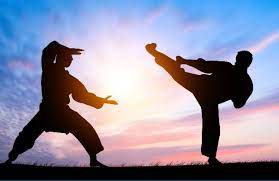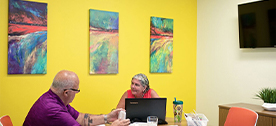
EVERYBODY was Kung Fu fighting?
I actually have this phrase on my car’s license plate holder. A gift from my daughter who thought she was very clever. She was. I get a comment from someone at least once a week that has seen the license plate holder and got a kick out of it. No, everyone was not Kung Fu fighting. I was there, I can testify.
That of course is the problem with absolutes: everybody, nobody, always, never, etc. There is almost always an exception. So, I started thinking about absolutes within the shared space and meeting room industry as well.
Not everyone was actually Kung Fu fighting. That is true. I, for one, was not Kung Fu fighting. Similarly, meeting and conference room spaces may not be occupied by everyone at all times. Some individuals or teams may not require or attend meetings, while others may utilize these spaces more frequently. Not everyone is involved in every meeting or requires the same level of meeting room access. And some people prefer to participate in meetings virtually while the rest of the team is together in one meeting space.
Just as not everyone was Kung Fu fighting, meeting and conference room spaces may not always be available to accommodate all individuals or teams simultaneously. The availability of these spaces can vary depending on factors such as scheduling conflicts, limited room capacity, or high demand. There may be limitations on the number of people or teams that can utilize meeting rooms at any given time – especially during the magic hour (whenever that is) that apparently several groups seem to think they all need space at exactly the same time.

Not everyone wants to be a Kung Fu fighter nor is it the sole activity or interest of everyone. Similarly, meeting and conference room spaces cater to various needs and interests. Different types of meetings, discussions, presentations, and collaborations take place in these spaces, reflecting the diverse range of activities and topics that individuals and teams engage in during their work.
While not everyone was Kung Fu fighting, the implication is there that some people were indeed engaged in the activity. Similarly, meeting and conference room spaces facilitate collaboration and communication among participants. They provide a dedicated environment where individuals can come together, exchange ideas, make decisions, and work collectively, collaboratively towards common goals.
If we assume that not everyone was Kung Fu fighting, that suggests that different individuals may have different preferences, skills, or interests. Meeting and conference room spaces should also be flexible to accommodate different meeting formats, sizes, and requirements. They should offer versatility in terms of room layouts, audiovisual equipment, and amenities to meet the diverse needs of participants.
Finally, the phrase questions that not everyone was actively Kung Fu fighting. Similarly, meeting and conference room spaces should encourage active engagement and participation from all attendees. It’s important to create an inclusive and conducive environment where individuals feel comfortable expressing their ideas, contributing to discussions, and actively participating in the meeting or conference.
As my daughter rightly questioned the prevalence of Kung Fu fighting, we should also not assume that all meeting and conference room spaces are the same – participation, availability, diversity of interest, collaboration opportunities, flexibility and engagement vary widely in both meeting spaces and Kung Fu fighting.
At Office Evolution Phoenix we offer meeting and conference spaces for business, individuals, community members and organizations to use for their varying and divergent needs.
We do not offer Kung Fu fighting.
At Office Evolution Phoenix, we provide virtual office, coworking, and flex office private office solutions at our shared office center. We offer meeting rooms, private offices, hot desking in a shared workspace coworking lounge, a shared reception, a business address, and virtual receptionist services. We have many options and price points, and all terms are flexible. Plus, you become part of a community of like-minded professionals.
Whether you live in Phoenix, Ahwatukee, Chandler, Gilbert, Tempe, Guadalupe, Mesa, Laveen, Maricopa or Casa Grande or other communities nearby in Maricopa County, OR you just arrived at Sky Harbor Airport and need a place to meet or work, choosing Office Evolution Phoenix will help you be more professional, productive, and profitable.
Everybody was Kung Fu Fighting | Origin
In 1974, Carl Douglas, an artist whose name is synonymous with a cultural phenomenon, captured global attention with his chart-topping song, “Everybody Was Kung Fu Fighting.” This song was more than just an infectious tune; it was a celebration of the rising popularity of martial arts in Western culture. At the core of its catchy lyrics was an homage to ancient Chinese art, embodying a fusion of music and kung fu, a martial art form steeped in history and discipline. The song paid tribute to icons of the genre, such as Bruce Lee, and fictional characters like Kung Fu Panda, making them a part of mainstream discourse. The fact that such a song could rise to the top of the charts signified a change in cultural acceptance, marking a shift in the perception of Asian culture in the West.
The song’s iconic line, “Everybody was kung fu fighting, those kicks were fast as lightning,” captured the energy and sudden motion inherent to the martial art. It painted a vivid picture of “funky Chinatown,” a place where “funky China men” and “little Sammy Chung” come alive in the listeners’ imagination. Douglas’s lyrics aren’t just an expression of admiration for the art form; they are a tribute to a lifestyle deeply rooted in discipline, skill, and respect for tradition. “Everybody Was Kung Fu Fighting,” while being a one-hit wonder, transcended the borders of music to touch upon broader cultural events and societal shifts, a testament to the power of art in influencing perceptions and bringing about change.